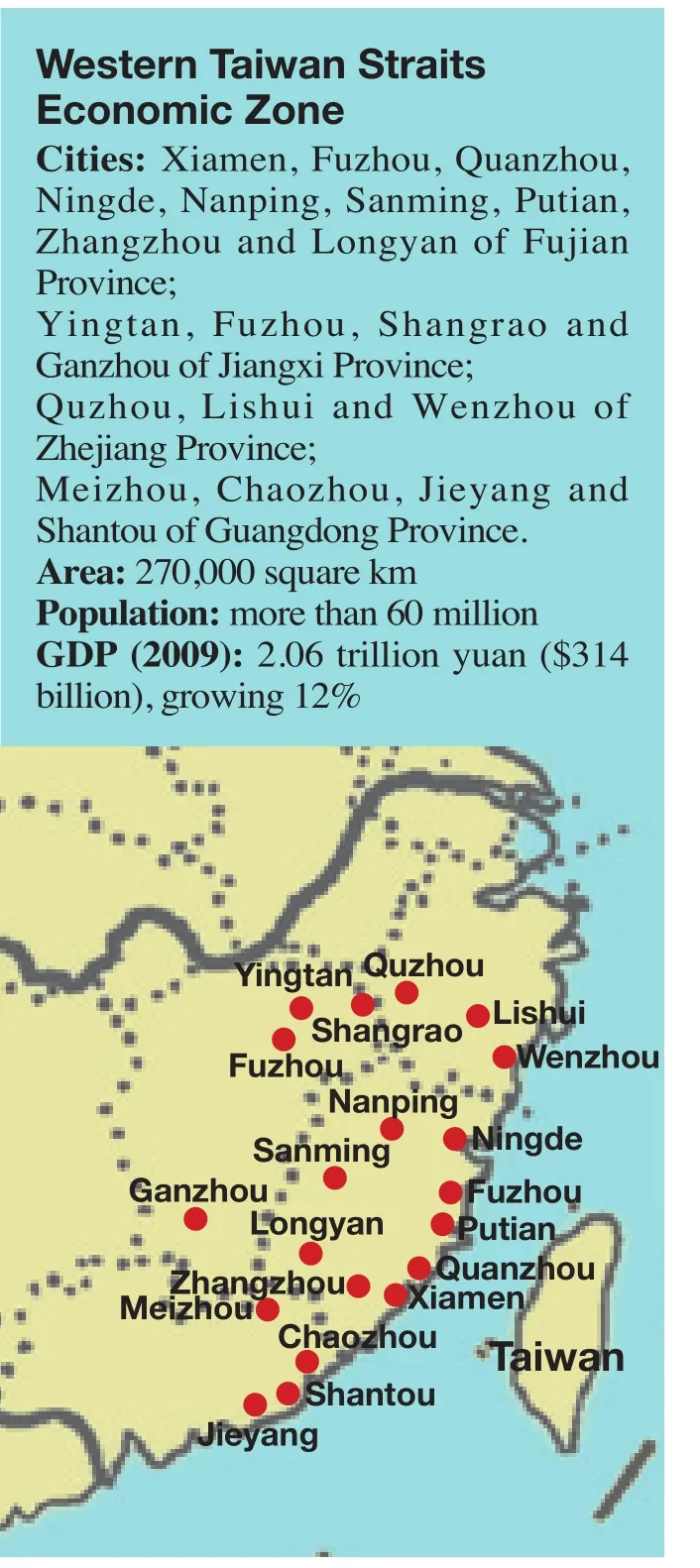Bridging the Straits
2011-10-14ByLIUXINLIAN
By LIU XINLIAN
By LIU YUNYUN
Bridging the Straits
By LIU XINLIAN
A new economic zone in China’s east coastal region will open new trade possibilities across the Taiwan Straits
The State Council approved a program on March 11 to develop the region on the west side of the Taiwan Straits, another major step forward in turning the blueprint for the Western Taiwan Straits Economic Zone into concrete measures.
In May 2009, the State Council passed the Decisions on Accelerating the Construction of the Western Taiwan Straits Economic Zone to strengthen cross-Straits economic cooperation and cultural exchange, improve infrastructure on the western side of the Straits and integrate the economic zone into China’s national development strategy.
The economic zone covers nine cities in Fujian Province, including the provincial capital Fuzhou and the coast city Xiamen, and 11 cities in neighboring Zhejiang, Jiangxi and Guangdong provinces.
The Western Taiwan Straits Economic Zone will be divided into three functional zones in accordance with their different background, resources and environment—namely, the coastal port industrial area in the east, and an industrial area and an ecological industry area in the central and western parts, according to the development program.
“Taiwanese businessmen will see new investment opportunities through the economic zone. Our hope is that their investments in the western Taiwan Straits region will accelerate,” said Tang Yonghong, a research fellow with the Taiwan Research Institute of Xiamen University.
Some preferential policies for investment from Taiwan might be special admission into industries not open to foreign funds, said Tang.
Linking Taiwan
Since the frst Taiwan-funded enterprise was established in Xiamen in 1983, the mainland has become Taiwan’s biggest trade partner, investment destination and export market, according to Sun Shengliang, a researcher with the Institute of Taiwan Studies at the Chinese Academy of Social Sciences (CASS).
Statistics from the Ministry of Commerce show the trade volume between the Chinese mainland and Taiwan reached $145.37 billion last year, up 36.9 percent year on year. The mainland approved 3,072 Taiwanese investment projects on the mainland in 2010, up 20.2 percent from the previous year. The paid-in investment from Taiwan reached $2.48 billion, up 31.7 percent year on year. By the end of 2010, a total of 83,133 Taiwan investment projects were approved worth $52.02 billion. Taiwanese investment accounts for 5 percent of total overseas investment on the mainland.
The two sides of the Taiwan Straits complement each other economically and could cooperate in many industries, said Sun.
Taiwan has advantages in capital, technology, management and marketing, while China’s mainland enjoys rich labor resources, a high economic growth rate, big market capacity and differentiated development levels, said Sun.
Foxconn, the world’s largest maker of electronic components from Taiwan, employs more than 800,000 workers on China’s mainland. Last year Foxconn’s branch in Shenzhen realized a total export volume of $48 billion, accounting for nearly 24 percent of Shenzhen’s annual export total.
“Taiwan is strong in some laborintensive industries, such as information technology, high crystal displayer, processing manufacturing and electrical equipment. The low labor cost on the mainland has attracted Taiwanese investors and allowed them to reap handsome profits,” said Hu Angang, a professor at Tsinghua University’s School of Public Policy and Management.
The 12th Five-Year Plan (2011-15), a blueprint for the country’s development in the next fve years, includes a special chapter elaborating on the further expansion of cross-Straits economic cooperation.
“It shows the Chinese Government’s resolve to develop and strengthen cross-Straits ties in the next fve years,” said Hu.
The people on the two sides of the Straits are also closely linked because they have the same ancestors, speak the same dialect and share the same customs and cultural traditions. People from Fujian began to move to Taiwan more than 1,700 years ago. According to statistics published in Taiwan, people of Fujian origin comprise 80 percent of Taiwan’s population of 23 million.
Better infrastructure
Located opposite Taiwan across the Straits, Fujian holds the principal position in the whole Western Taiwan Straits Economic Zone and boasts unique advantages in communicating with Taiwan, said the development program for the economic zone. With the second longest coastline in the country, Fujian has more than 22 large harbors.
But Fujian has not always been Taiwan’s top investment destination. Last year, Jiangsu Province, Guangdong Province and Shanghai Municipality were the top three investment destinations from Taiwan--Fujian ranked fourth.
Taiwan’s annual direct investment in Fujian declined over time not only in terms of the absolute amount but also the relative term compared to other Chinese provinces. By the end of 1998, the shares of Taiwan’s direct investment in Guangdong, Jiangsu (including Shanghai), Fujian and Zhejiang to the total on the mainland were 34.1 percent, 31.4 percent, 11.4 percent and 4.4 percent, respectively. By the end of 2005, these shares changed to 27.8 percent, 44.9 percent, 8.2 percent and 6.8 percent.
“It’s evident that Fujian didn’t attract enough of Taiwan’s investment through its geographic, cultural and language advantage compared to other Chinese provinces. Many Taiwan businesspeople have been migrating to northern parts. This should be a major concern for the Fujian Provincial Government,” said Chen-yuan Tung, a professor at the College of Social Sciences at the National Chengchi University based in Taiwan.
Compared with other Chinese coastal provinces, Fujian suffers from many disadvantages in attracting Taiwan’s investment in terms of market size, transportation convenience and industrial structure. For instance, in terms of comprehensive competitiveness of Chinese cities, Xiamen in the economic zone was not in the top 10 competitive Chinese cities released by the CASS last April. Fujian’s GDP ranking among 31 Chinese provinces and municipalities declined from No. 9 in 2001 to No. 12 in 2010.
According to Zeng Qinzhao, Chairman of the Xiamen Club for Taiwanese Businesspeople, the Western Taiwan Straits Economic Zone lags behind the Yangtze River Delta and Pearl River Delta mainly in its transportation.
In this sense, reinforcing infrastructural construction was given special priority in the development program. In the future, five expressways will connect Fuzhou and 11 other major cities in the zone, said Wang Kaiming, Director of the Fujian Provincial Government Development Research Center.
The intercity railways will help cut the travel time between any city in the zone to three hours, said Chen Qingfu, Director of the Corporate Planning Center with Fujian Provincial Development and Reform Commission.
“More convenient transportation and less travel time will help in the zone, and will further promote the development of the whole zone,” said Chen.
The province also gave priority to construction of deep-water harbors at Xiamen, Fuzhou and Meizhou to increase their transportation capacity and competitiveness in urban development.
The mainland will build four new airports and renovate four others in the Western Taiwan Straits Economic Zone in the next five years, said Li Jiaxiang, Director of the Civil Aviation Administration of China.
Island platform
As the most important part of the Western Taiwan Straits Economic Zone, Fujian will develop its Pingtan Island into a pilot area for cross-Straits economic cooperation.
Pingtan Island, which lies 28 km from Fuzhou and around 120 km from Taiwan, is the ffth largest island in China, almost twice the size of Hong Kong and Xiamen.
Construction of Pingtan Comprehensive Experimental Zone will be promoted, said the development program.
“Based on its unique and strategic location, we are going to build a special economic zone to enhance cross-Straits industrial cooperation,” said Chen Hua, Vice Governor of Fujian.
Chen hopes Pingtan will become the frontier platform for cross-Straits cooperation by building a modern industrial system with distinct characteristics and ensuring mutual benefts.
Municipal and provincial governments will offer subsidies to build a 95.64-km road around the island.
In addition to expanding Fuzhou’s bonded area to Pingtan, the country will also build an area under special customs supervision in Pingtan to facilitate trade between the mainland and Taiwan.
“At that time, people, ships and cargo from Taiwan will enter and leave Pingtan freely, as if it were their own home,” Chen said.


ZHANG GUOJUN
Last November, the 4,976-meter-long Pingtan Cross-Straits Bridge was opened, ending the need to use ferries to reach the island. A second cross-Straits bridge is being planned.
The Yuping expressway connecting Pingtan and Fuqing completed last December shortened the travel time between Pingtan and Fuzhou to 1.5 hours from 2.5 hours.
Up to fve ports, including a 200,000-toncapacity port and two 300,000-ton-capacity ports, are being planned.
The capacity of Pingtan’s wastewater processing plant will be expanded from 10,000 tons per day to 30,000 tons per day, and another two plants will be built.
By LIU YUNYUN
